Wikipedia:Main Page history/2021 September 3b
From today's featured articleThe
Recently featured:
Did you know ...
|
In the news Flooding in the U.S. state of Pennsylvania
On this day
More anniversaries:
|
From today's featured list
The Moortidevi Award is an Indian literary award annually presented by the Bharatiya Jnanpith, a literary and research organisation. The award is given only to Indian writers writing in Indian languages included in the Eighth Schedule to the Constitution of India, and in English, with no posthumous conferral or self nomination. From 2003, the award was given to the authors for their "contemplative and perceptive work" and consisted of a cash prize of ₹1 lakh (US$1,600), a citation plaque, a shawl, and a statue of Saraswati, the Hindu goddess of knowledge and wisdom. The cash prize was raised to ₹2 lakh (US$2,800) in 2011 and to ₹4 lakh (US$5,600) in 2013. The first recipient of the award was the Kannada writer C. K. Nagaraja Rao (pictured), who was honoured in 1983 for his novel, Pattamahadevi Shantala Devi, which was published in four volumes. The award has been conferred upon twenty-nine writers including one female author: In 1991, Odia academic and writer Pratibha Ray became the first woman to win the award and was honoured for the 1985 novel Yajnasani. Hindi writer and professor Vishwanath Tiwari is the most recent recipient of the award. (Full list...)
Today's featured picture

|
Photograph credit: National Institute of Allergy and Infectious Diseases, Rocky Mountain Laboratories
Recently featured:
|




